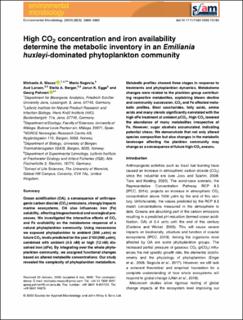| dc.contributor.author | Mausz, Michaela A. | |
| dc.contributor.author | Segovia, María | |
| dc.contributor.author | Larsen, Aud | |
| dc.contributor.author | Berger, Stella Angela | |
| dc.contributor.author | Egge, Jorun Karin | |
| dc.contributor.author | Pohnert, Georg | |
| dc.date.accessioned | 2021-07-02T12:24:44Z | |
| dc.date.available | 2021-07-02T12:24:44Z | |
| dc.date.created | 2020-10-04T14:07:06Z | |
| dc.date.issued | 2020 | |
| dc.Published | Environmental Microbiology. 2020, 22 (9), 3863-3882. | |
| dc.identifier.issn | 1462-2912 | |
| dc.identifier.uri | https://hdl.handle.net/11250/2763125 | |
| dc.description.abstract | Ocean acidification (OA), a consequence of anthropogenic carbon dioxide (CO2) emissions, strongly impacts marine ecosystems. OA also influences iron (Fe) solubility, affecting biogeochemical and ecological processes. We investigated the interactive effects of CO2 and Fe availability on the metabolome response of a natural phytoplankton community. Using mesocosms we exposed phytoplankton to ambient (390 μatm) or future CO2 levels predicted for the year 2100 (900 μatm), combined with ambient (4.5 nM) or high (12 nM) dissolved iron (dFe). By integrating over the whole phytoplankton community, we assigned functional changes based on altered metabolite concentrations. Our study revealed the complexity of phytoplankton metabolism. Metabolic profiles showed three stages in response to treatments and phytoplankton dynamics. Metabolome changes were related to the plankton group contributing respective metabolites, explaining bloom decline and community succession. CO2 and Fe affected metabolic profiles. Most saccharides, fatty acids, amino acids and many sterols significantly correlated with the high dFe treatment at ambient pCO2. High CO2 lowered the abundance of many metabolites irrespective of Fe. However, sugar alcohols accumulated, indicating potential stress. We demonstrate that not only altered species composition but also changes in the metabolic landscape affecting the plankton community may change as a consequence of future high-CO2 oceans. | en_US |
| dc.language.iso | eng | en_US |
| dc.publisher | Wiley | en_US |
| dc.rights | Navngivelse-Ikkekommersiell 4.0 Internasjonal | * |
| dc.rights.uri | http://creativecommons.org/licenses/by-nc/4.0/deed.no | * |
| dc.title | High CO2 concentration and iron availability determine the metabolic inventory in an Emiliania huxleyi-dominated phytoplankton community | en_US |
| dc.type | Journal article | en_US |
| dc.type | Peer reviewed | en_US |
| dc.description.version | publishedVersion | en_US |
| dc.rights.holder | Copyright 2020 The Authors | en_US |
| cristin.ispublished | true | |
| cristin.fulltext | postprint | |
| cristin.qualitycode | 2 | |
| dc.identifier.doi | 10.1111/1462-2920.15160 | |
| dc.identifier.cristin | 1836855 | |
| dc.source.journal | Environmental Microbiology | en_US |
| dc.source.40 | 22 | |
| dc.source.14 | 9 | |
| dc.source.pagenumber | 3863-3882 | en_US |
| dc.relation.project | Norges forskningsråd: 225956/E10 | en_US |
| dc.relation.project | EC/FP7/228224 | en_US |
| dc.relation.project | EC/H2020/250254 | en_US |
| dc.identifier.citation | Environmental Microbiology. 2020, 22(9), 3863-3882 | en_US |
| dc.source.volume | 22 | en_US |
| dc.source.issue | 9 | en_US |

